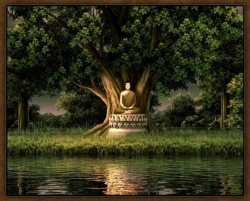The Spiritual Journey of Janapada Kalyani
When all hopes of Nanda’s return withered away, Janapada Kalyani gradually recovered from her trauma. Further, in course of time, she felt that her entire life was going to be a waste, and there was nothing very significant for her to pursue, she, too, decided to join the Order. So, she renounced the worldly life under the guidance of Pajapati joined the Order because by then the Buddha had allowed the admission of the nuns in his Sangha.
Though she renounced the world yet, her attachment to her body was intense. She still fostered her pride for her physical beauty. Further, she never dared to listen to the Buddha’s sermons, which highlighted the transience of all worldly phenomena including the physical beauty. Besides, she never allowed the thought that her surpassing beauty would fade one day.
Nonetheless, one day, she visited the Buddha to hear his preaching along with other nuns of the monastery. The Buddha had known her mind. So, he created the form of the most gorgeous maiden, who stood fanning him before he started his discourse that day.
When listening to the discourse Janapada Kalyani was still quite conscious of her beauty and was thinking about it. But when the sermon of the Buddha progressed, she saw herself ageing fast and reaching the stage of extreme old age, with all her skins wrinkled; hair turning grey; drooping of the firmness of her breasts; and the sudden change in the people’s gaze, which was no longer lustful. Further, passing through that stage she saw herself dead; and her body decomposed to become a mass of filth. This demonstration made her spiritually elevated and she became a Sotapanna. Laater, upon hearing the Buddha’s Kayavicchandika Sutta (The discourse on the process of the decomposition of the body) she attained arahatahood.See Samyutta Nikaya iv.341; Udana Commentary 170; Jataka 1.394; Majjhima Nikaya i.387; Dhammapada Atthakatha i.105; Theragatha Atthakatha i.318.
